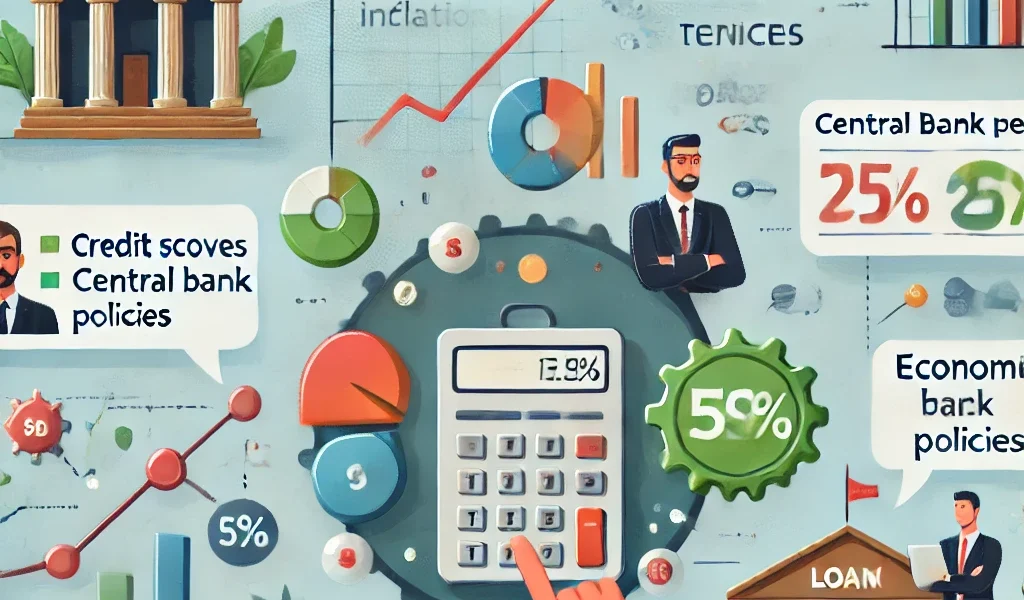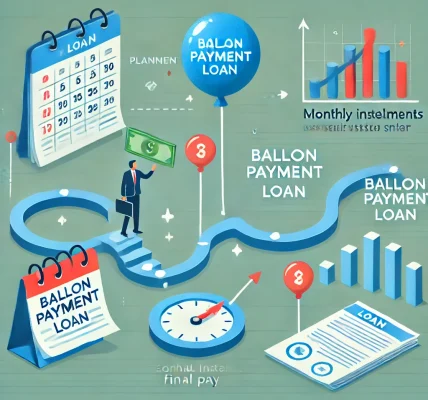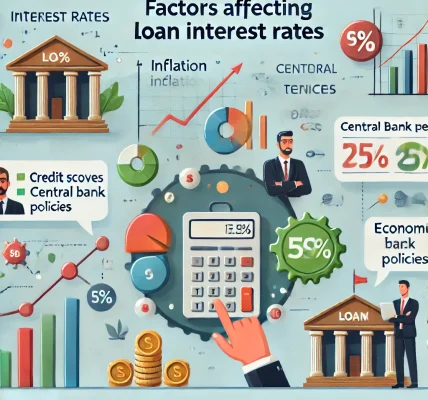Introduction
Interest rates play a crucial role in determining the affordability of loans for borrowers. Whether you are applying for a personal loan, home loan, or business loan, the interest rate directly impacts your monthly payments and overall financial burden. Loan interest rate policies are governed by several factors that influence how lenders determine the cost of borrowing.
Understanding these factors can help borrowers make informed decisions and plan their finances effectively. In this article, we will explore the top factors that influence loan interest rate policies and how they affect borrowers.
1. Monetary Policy and Central Bank Rates
One of the most significant factors influencing loan interest rates is the monetary policy set by a country’s central bank (e.g., the Federal Reserve in the U.S. or the Reserve Bank of India). Central banks regulate interest rates by adjusting the benchmark lending rate, known as the repo rate or federal funds rate.
How It Affects Loan Interest Rates:
- When the central bank raises interest rates, borrowing becomes more expensive as banks pass on the higher costs to consumers.
- Lower interest rates encourage borrowing and economic growth, leading to cheaper loans for consumers.
2. Inflation Rate
Inflation is the rate at which the general price level of goods and services increases over time. It has a direct impact on interest rate policies because lenders need to ensure that the money they lend maintains its value.
How It Affects Loan Interest Rates:
- High inflation usually leads to higher interest rates to prevent excessive borrowing and spending.
- Low inflation allows lenders to offer lower interest rates, making loans more affordable.
3. Credit Score and Credit History
A borrower’s creditworthiness is a crucial determinant of the interest rate they receive. Lenders assess credit scores (such as FICO in the U.S. or CIBIL in India) to evaluate the risk of default.
How It Affects Loan Interest Rates:
- Higher credit scores result in lower interest rates since lenders perceive the borrower as low-risk.
- Poor credit history or low credit scores lead to higher interest rates due to increased default risk.
4. Loan Type and Purpose
Different types of loans have varying interest rate structures. The purpose of the loan also influences the risk perception of lenders.
How It Affects Loan Interest Rates:
- Secured loans (such as home and auto loans) generally have lower interest rates because they are backed by collateral.
- Unsecured loans (such as personal and business loans) tend to have higher interest rates due to increased risk.
- Government-backed loans may have lower interest rates due to financial guarantees.
5. Loan Tenure (Duration of Loan)
The length of the loan term significantly impacts interest rates. Short-term and long-term loans have different risk levels and pricing.
How It Affects Loan Interest Rates:
- Short-term loans typically have lower interest rates as they pose less risk to lenders.
- Long-term loans may have higher interest rates due to extended repayment periods and inflation risks.
6. Market Competition and Lender Policies
The level of competition among banks and financial institutions influences loan interest rate policies.
How It Affects Loan Interest Rates:
- In a highly competitive market, lenders may lower interest rates to attract more customers.
- During financial crises or low liquidity periods, lenders may raise interest rates to mitigate risks.
7. Employment Status and Income Level
Lenders assess a borrower’s employment stability and income level to determine their repayment capacity.
How It Affects Loan Interest Rates:
- Salaried employees with stable jobs may receive lower interest rates.
- Self-employed individuals or those with variable incomes may face higher interest rates due to income instability.
8. Debt-to-Income (DTI) Ratio
The debt-to-income ratio measures a borrower’s total monthly debt payments relative to their income. It is a key factor in assessing loan affordability.
How It Affects Loan Interest Rates:
- A lower DTI ratio indicates financial stability and results in better interest rates.
- A high DTI ratio suggests a higher risk of default, leading to increased interest rates.
9. Down Payment and Collateral
Lenders consider the borrower’s contribution to the loan (down payment) and the presence of collateral in secured loans.
How It Affects Loan Interest Rates:
- A higher down payment reduces the loan amount, lowering the risk for lenders and resulting in lower interest rates.
- Loans backed by valuable collateral (such as property or gold) tend to have lower interest rates.
10. Economic Conditions and Global Factors
Broader economic conditions, including global financial markets, recession, or geopolitical events, impact interest rate policies.
How It Affects Loan Interest Rates:
- During economic downturns, central banks may lower interest rates to boost spending and lending.
- Economic uncertainty or financial crises can lead to higher interest rates due to increased risk.
11. Fixed vs. Floating Interest Rates
Lenders offer both fixed and floating interest rate options, which affect loan repayment terms.
How It Affects Loan Interest Rates:
- Fixed interest rates remain constant throughout the loan tenure, providing stability.
- Floating interest rates fluctuate based on market conditions, making them riskier but potentially lower in favorable conditions.
12. Government Policies and Regulations
Government regulations, such as subsidy programs, interest rate caps, or lending guidelines, impact loan interest rate policies.
How It Affects Loan Interest Rates:
- Governments may introduce policies to lower interest rates for priority sectors (e.g., affordable housing loans).
- Regulatory measures can influence how lenders structure their loan products.
13. Bank-Specific Risk Assessment Models
Each financial institution has its own risk assessment model that determines the interest rates offered to borrowers.
How It Affects Loan Interest Rates:
- Lenders use internal algorithms, customer profiles, and market trends to set interest rates.
- Riskier borrower profiles are assigned higher interest rates based on internal scoring mechanisms.
Conclusion
Loan interest rate policies are shaped by multiple factors, including central bank regulations, economic conditions, borrower creditworthiness, and lender-specific policies. Understanding these factors can help borrowers negotiate better interest rates and choose the most cost-effective loan options.
Before applying for a loan, borrowers should assess their financial situation, improve their credit scores, and compare offers from multiple lenders. Being informed about interest rate policies ensures smarter financial decisions and long-term financial stability.




